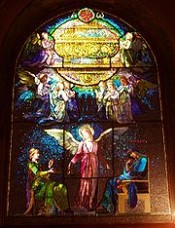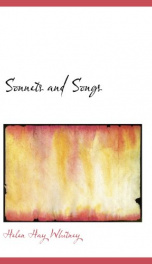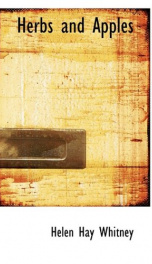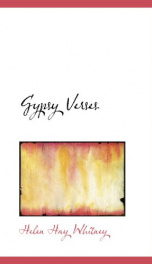Whitney Helen Hay

John La Farge (March 31, 1835 – November 14, 1910) was an American painter, muralist, stained glass window maker, decorator, and writer. Born in New York City, New York, his interest in art began during his training at Mount St. Mary's University[1] and St. John's College (now Fordham University). He had only the study of law in mind until he returned from his first visit to Paris, France where he studied with Thomas Couture and became acquainted with famous literary people of the city. LaFarge subsequently studied with painter William Morris Hunt in Newport.[2] Even LaFarge's earliest drawings and landscapes, done in Newport, Rhode Island, after his marriage in 1861 to Margaret Mason Perry, sister-in-law of Lilla Cabot Perry, show marked originality, especially in the handling of color values, and also the influence of Japanese art, in the study of which he was a pioneer. Between 1859 and 1870, he illustrated Tennyson's Enoch Arden and Robert Browning's Men and Women. Breadth of observation and structural conception, and a vivid imagination and sense of color are shown by his mural decorations. His first work in mural painting was done in Trinity Church, Boston, in 1873. Then followed his decorations in the Church of the Ascension (the large altarpiece) and St. Paul's Chapel (Columbia University), New York. For the Minnesota State Capitol at St. Paul he executed, at age 71, four great lunettes representing the history of law, and for the Supreme Court building at Baltimore, a similar series with Justice as the theme. In addition there are his vast numbers of other paintings and water colors, notably those recording his extensive travels in the Orient and South Pacific. His labors in almost every type of art won for him from the French Government the Cross of the Legion of Honor and membership in the principal artistic societies of America, as well as the presidency of the National Society of Mural Painters from 1899 through 1904. Enjoying an extraordinary knowledge of languages (ancient and modern), literature, and art, by his cultured personality and reflective conversation he influenced many other people. Though naturally a questioner he venerated the traditions of religious art, and preserved always his Catholic faith and reverence. During 1904, he was one of the first seven artists chosen for membership in the American Academy of Arts and Letters. On his passing in 1910, John LaFarge was interred in the Green-Wood Cemetery in Brooklyn, New York. During his life, he maintained a studio at 51 West 10th Street, in Greenwich Village, which is now part of the site of Eugene Lang College.[3] La Farge experimented with color problems, especially in the medium of stained glass. He succeeded not only in rivaling the gorgeousness of medieval windows, but in adding new resources by his invention of opalescent glass and his original methods of superimposing and welding his material. Among his many stained glass masterpieces are: His eldest son, Christopher Grant LaFarge, was a partner in the New York-based architectural firm of Heins & LaFarge, responsible for projects in Beaux-Arts style, notably the original Byzantine Cathedral of St. John the Divine, the Yale undergraduate society St. Anthony Hall (extant 1893-1913) pictured at,[4] and the original Astor Court buildings of the Bronx Zoo. His son Oliver Hazard Perry LaFarge I became an architect and real estate developer. Part of his career in real estate was in a Seattle partnership with Marshall Latham Bond, Bond & LaFarge. During the year 1897 to 1898 Seattle real estate which had been extremely prosperous was in a "slump". The partners left and participated in the Klondike Gold Rush. Among the camp fire mates at Dawson City during the Fall of 1897 was Jack London who rented a tent site from Marshall Bond. In Seattle the Perry Building designed after LaFarge returned is still standing. Later on in life O.H.P. LaFarge designed buildings for General Motors. Another of his sons, John LaFarge S.J., became a Jesuit priest and a strong supporter of anti-racist policies. He wrote several books and articles before World War II on this subject, one of which caught the attention of Pope Pius XI, who summoned him to Rome and asked him to develop a new encyclical, Humani Generis Unitas, against Nazi policies. John LaFarge completed the encyclical, but unfortunately it reached Pius XI only three weeks before the pope's death. It remained buried in the Vatican archives and was only rediscovered a few years ago. John LaFarge S.J. was born February 13, 1880 and died November 25, 1963. His most famous books are The Manner is Ordinary (1953), Race Relations (1956), and Reflections on Growing Old (1963). Kilauea, Looking at Cone of Crater, watercolor painting by John LaFarge, 1890, Honolulu Academy of Arts View in Ceylon, near Dambula, painting by John LaFarge Young Girls Preparing Kava Outside of the Hut whose Posts are Decorated with Flowers, painting by John LaFarge, c. 1891 Agathon to Erosanthe, Votive Wreath, painting by John LaFarge, 1861 Girls Carrying a Canoe, Vaiala in Samoa, painting by John LaFarge, 1891 Paradise Valley, painting by John LaFarge, 1866-8 Portrait of Faase, the Taupo of the Fagaloa Bay, Samoa, painting by John LaFarge, 1881 Portrait of the Novelist Henry James, by John LaFarge The Great Statue of Amida Buddha at Kamakura, painting by John LaFarge, 1886 This article incorporates text from the public-domain Catholic Encyclopedia of 1913.
do you like this author?
What readers are saying
What do you think? Write your own comment on this book!
write a commentWhat readers are saying
What do you think? Write your own comment on this author!
write a commentWhat readers are saying
What do you think? Write your own comment on this author!
write a commentif you like Whitney Helen Hay try:
readers also enjoyed
What readers are saying
What do you think? Write your own comment on this author!
write a commentGenre
if you like Whitney Helen Hay try:
readers also enjoyed
Do you want to read a book that interests you? It’s EASY!
Create an account and send a request for reading to other users on the Webpage of the book!





